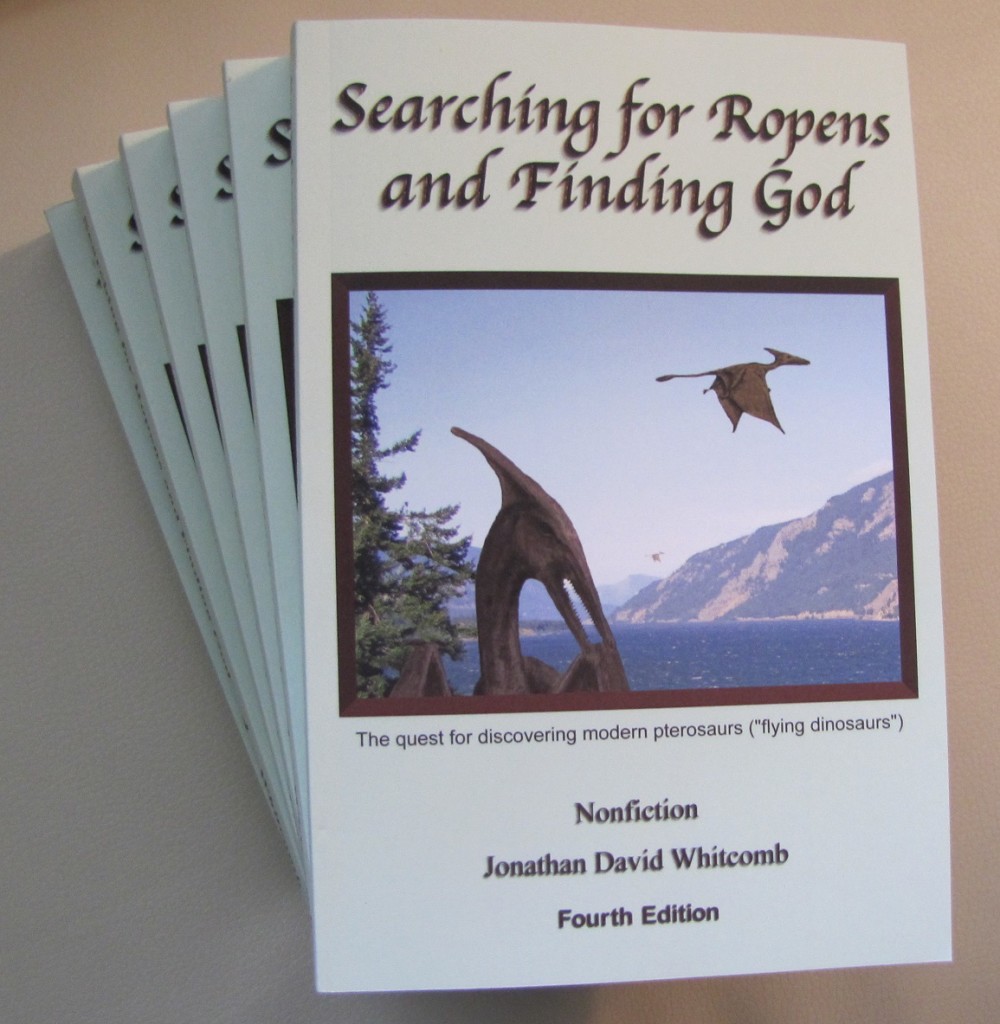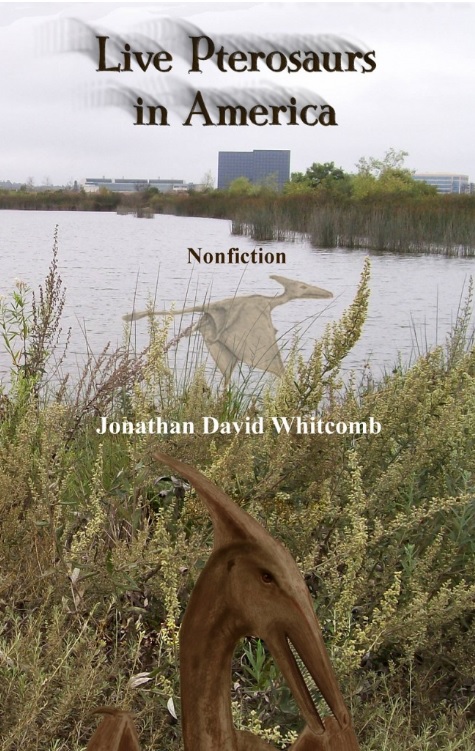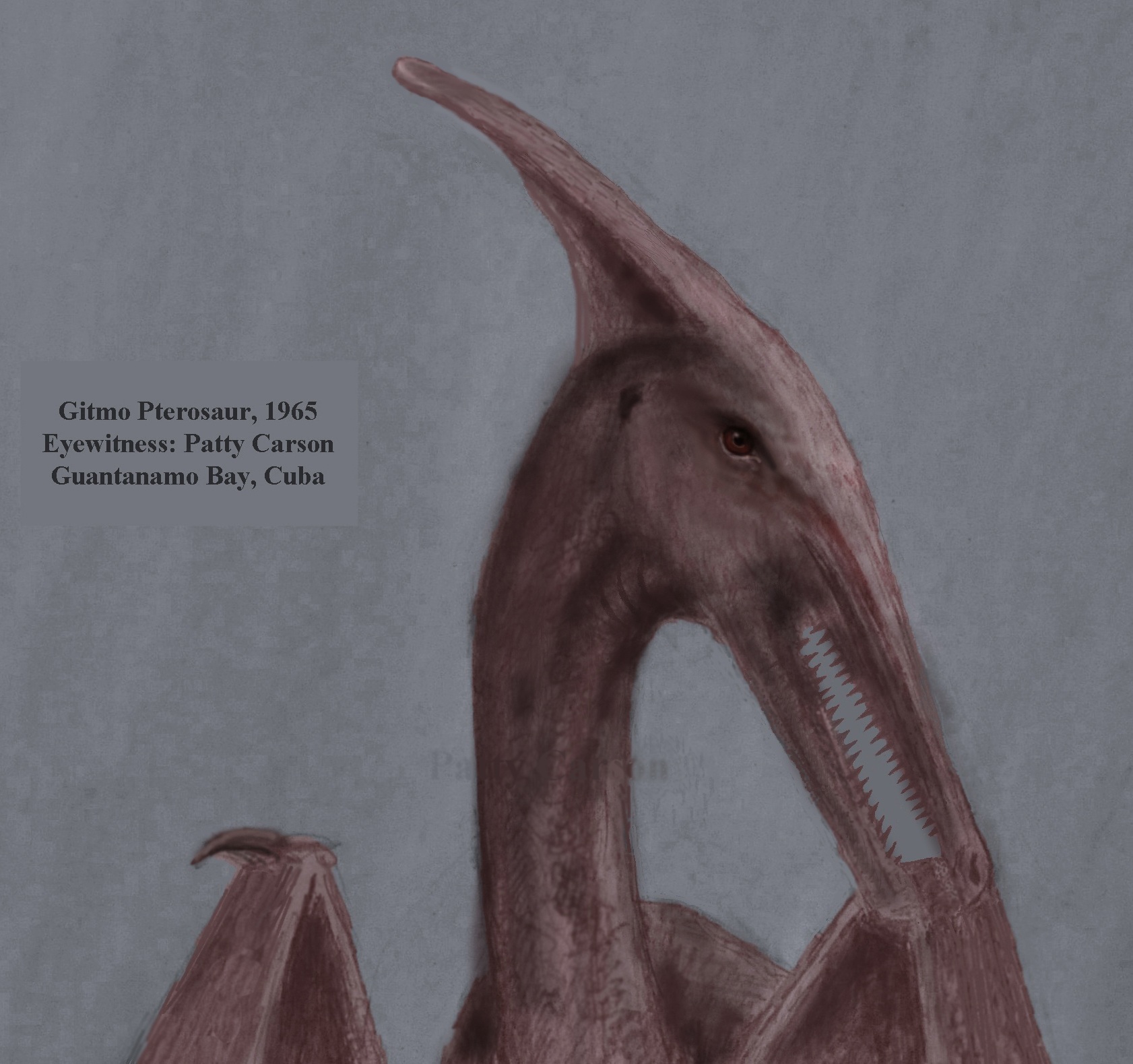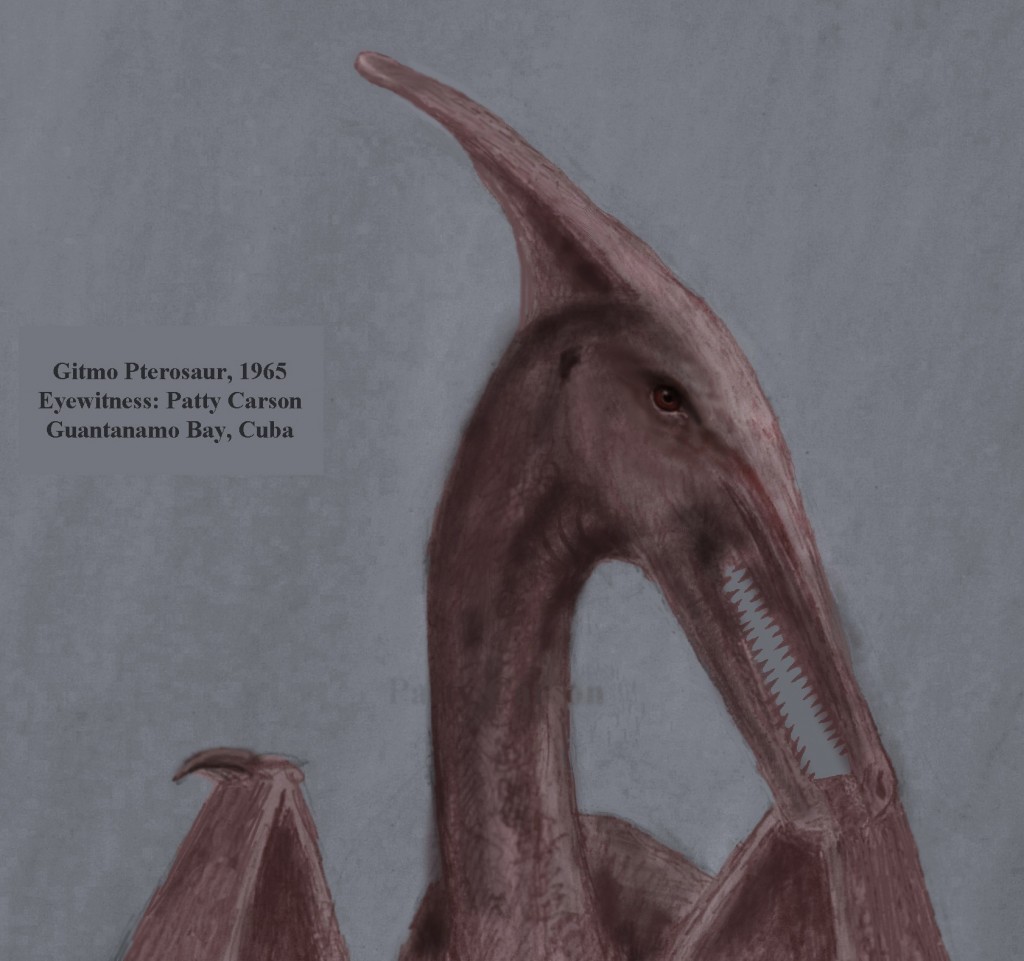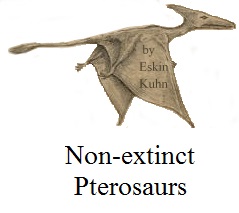By living-pterosaur investigator Jonathan D. Whitcomb
News about a non-ropen pterosaur in PNG
Last week, I found a Youtube documentary on an expedition on New Britain Island, Papua New Guinea, in which two Americans, Milt Marcy and Peter Beach, were searching for a living pterosaur. They spent quite a few weeks on that remote tropical island in 2015, but they were rewarded with a sighting of a flying creature that others had previously seen in that area: a non-extinct pterosaur. This was observed in daylight.
I sometimes refer to this modern pterosaur as the “New Britain Creature.” I don’t know what natives call it, but I believe that many English people of the world would have called this kind of flying creature “dragon” in earlier human history. Let’s consider sightings in the late 20th century, before getting into the encounter in 2015. Keep in mind that all eleven of these sightings were in the same area deep in the interior of New Britain Island, and not one of them appeared to be the same species as the long-tailed ropen observed in other areas of Papua New Guinea.
Around 1965, some of the natives in this general area of New Britain got access to a gun and shot a pterosaur. They then cooked it in three large pots, feeding the village. This event was told to Marcy and Beach by two of the older natives, Fraggie and Hulio, who were boys at the time of the feast. Apparently, however, Marcy and Beach stayed in a different village than the one in which Fraggie and Hulio remembered enjoying that home-cooked meal.
By the way, Peter Beach is a biologist and once taught biology in a small college in the Portland, Oregon, area.
Sighting by Marvin Sconce
His son was a missionary deep in the interior of New Britain Island when Marv Sconce encountered three flying creatures there, in the early afternoon of a spring day in 1989. They were gliding in single file, at a slight downward angle, and he saw them for about a minute or two, starting when they were about three hundred feet above him. The three apparent pterosaurs glided over a river valley that was below the eyewitness, and the last he saw of them they were a little below him, following the course of that valley.
Garth Guessman interviewed Marv in August of 2006, and before the end of that year had given me the detailed eyewitness sighting report. It included the following:
- No indication of feathers or hair
- No feathers obscured the creatures’ muscular physique
- [general] color: dark brown or black
- head shape: Had point on back of head with no color difference
- neck length: 8-10 inches
- wingspan: 10-12 feet
- Marvin saw no indication of a tail
Sighting by Harriet Sconce
The wife of Marvin, Harriet, had a sighting of one creature, on May 1, 1990, yet it was a close encounter. The following details were obtained from Guessman interviewing Harriet on October 15, 2006:
- The sighting lasted about two minutes
- She was about 30 feet away from the apparent pterosaur
- It was about 3:00-4:00 p.m., with a clear sky
- The animal was gliding at about 3 miles per hour
- It’s total length was about five feet
- “Smooth skin . . . like a bat wing, did not notice any hair”
- Head shape: “Pointed beak, like bird but much bigger, similar to crow”
- [head] “Crest? Yes, a pointy crest facing rearward”
- The wingspan she estimated to be 9-11 feet
- Harriet did not recall anything about a tail
Eight Sightings by Steve Sconce
Guessman interviewed Steve on October 8, 2006, obtaining information that included the following, regarding his eight sightings that occurred over a period of 18 months from 1990 to 1991:
- “Number of creatures: two or three in tandem . . . 20 to 30 feet apart”
- “Covering: leather, like a bat, not shiny: dull”
- “Head shape: pointy straight beak . . . Crests/Comb: about 8 inches”
- “Neck length: long . . . (18-24 inches)”
- “Sound: . . . like [scratching] a blackboard, but a much lower pitch.”
- No report or any indication of a tail

From the Youtube video on the expedition by Beach and Marcy
Sighting on New Britain Island in 2015
Milt Marcy and Peter Beach, both living in the Portland area of Oregon, went on an expedition in Papua New Guinea early in 2015, arriving in a remote village, deep in the interior of New Britain, on March 19th. Six days later, on March 25th, both Americans had their sighting of a pterosaur flying overhead.
I’ll quote from what they said in the Youtube documentary “PNG Expedition 2015 Documentary:”
Milt Marcy:
“We had a pretty momentous occasion.”
Pete Beach:
“I was in my hammock [sick], and I heard ‘big bird, big bird’ . . . I came out; I grabbed a camera that I had . . . and I looked up in the sky . . . It was almost directly above me. It was large, larger than any of the eagles or any of the other birds that we’d seen: leathery, had the claws on the wings . . . I saw the animal; I was stunned . . .
“I got the camera, so I turned the camera on, and I tried to focus in on it, but it was a very bright day [Beach had been indoors, suffering from pneumonia] . . . so I could not get a good view of the thing [with the camera]. I only had an LCD screen to look at . . .”
Beach did obtain video footage of the flying creature, but he was not able to zoom in to it. The video was examined by Wayne A. Hall, and the testimonies of eyewitnesses Peter Beach and Milt Marcy correlate with what is seen in the enhanced, enlarged images from that footage.
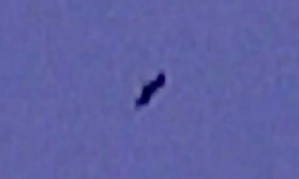
From video recorded by biologist Peter Beach
###
.
News of Living Pterosaurs on New Britain Island
The other day, I found a Youtube video about an expedition in Papua New Guinea in 2015, a search for a modern pterosaur on the island of New Britain. What a success it was!
.
Pterosaur expeditions in Papua New Guinea
The following are expeditions in which at least one American has traveled to Papua New Guinea to search for modern pterosaurs or at least to interview native eyewitnesses of those flying creatures or to make a television show with an apparently similar purpose . . .
.
Those who explore remote jungles searching for modern pterosaurs
Including Garth Guessman, Jacob Kepas, Paul Nation, Jonathan Whitcomb, and David Woetzel (to name only some of them)
.
Dinosaurs on New Britain Island
Since the 1990s, a large ‘reptilian’ creature has been sighted occasionally on Ambungi Island in West New Britain, Papua New Guinea. Ambungi Island is located on the south coast of West New Britain between Kandrian and Gasmata. . . . When shown the handbook by Hazel Richardson, Dinosaurs And Prehistoric Life . . . Robert identified a picture of a Therizinosaurus as closely matching the animal he observed, with the exception of one feature, i.e. the creature’s head.
.
The pterosaur is known by several names in the United States: “dinosaur bird,” “flying dinosaur,” and perhaps the most popular “pterodactyl.” In Papua New Guinea, it is known by many names: “ropen,” “duwas,” “indava,” and “kor.” But what shocks many Americans and Europeans are eyewitness reports that these supposedly “ancient” and “extinct” flying creatures are alive and well and even flying over our heads on rare occasions.
.
Living pterosaurs in Papua New Guinea
Brian Hennessy was one of several men who were in a truck driving down a mountain on Bougainville Island, New Guinea, in 1971. He heard the wing flapping of the flying creature be-fore he saw it. Jonathan Whitcomb, after interviewing Brian, concluded that the Australian had witnessed a ropen, but that conclusion was made more sure after he gave both Hennessy and Duane Hodgkinson a series of silhouette-sketch choices.
.
Americans saw a living pterosaur during World War II
This is a reply to a portion of a huge web page . . . by the living-pterosaur critic Glen Kuban: “Living Pterosaurs (‘Pterodactyls’)”.
.
Once I get into a sighting report or begin to interview an eyewitness, I care little about the label used for a particular flying creature. Common is the word pterodactyl, although some eyewitnesses call it a dinosaur bird or a dragon. I care much more about exactly what the person saw. I suggest using this approach.
.
~~~~~~~~~~~~~~~~~~~~~~~~~~~~~~~~~~~~~~~~~~~~~~~~~~~~~~~~~
The “Bible of modern pterosaurs” — Searching for Ropens and Finding God
This fourth edition of the nonfiction book is essential for all those who have any serious interest in these extraordinary flying creatures.
.
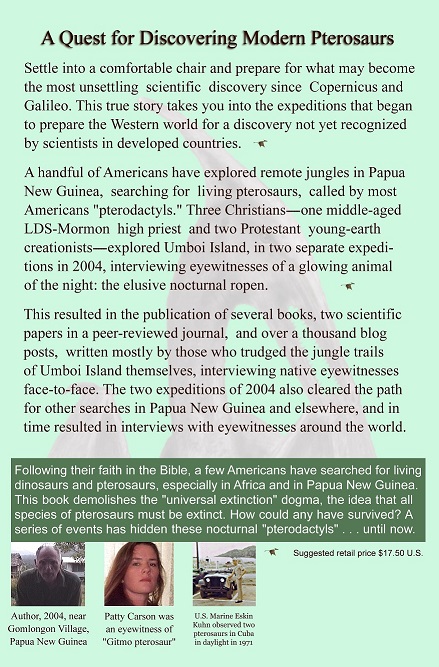
Pre-publication image of the back cover of this cryptozoology book



